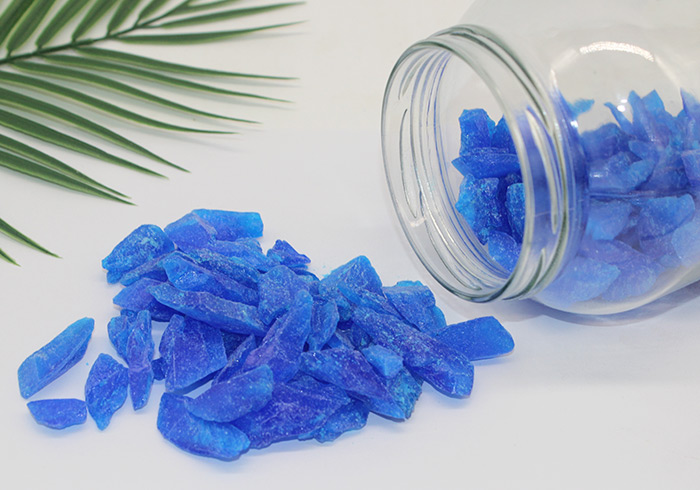copper sulfate (above 12mm)-www.918mz.com
product introduction:




physical and chemical properties:
natural or artificially manufactured hydrated copper sulfate crystals. irregular block shaped crystals of varying sizes, dark blue or light blue, semi transparent. exposed to dry air, slowly weathered. when heated and burned, it loses crystalline water and turns white. when it comes into contact with water, it turns blue again. crunchy, fragile, and soluble in water. odorless, with a metallic taste, bitter, astringent, and toxic.
copper sulfate pentahydrate is very stable at room temperature and pressure, does not deliquescence, and will gradually weather in dry air. when heated to 45 ℃, it loses two molecules of crystalline water, and when heated to 110 ℃, it loses four molecules of crystalline water, which is called copper sulfate monohydrate. at 200 ℃, all crystalline water is lost to form anhydrous substances, and five crystalline water can also be lost under the action of concentrated sulfuric acid. anhydrous substances also easily absorb water and transform into copper sulfate pentahydrate. after absorbing water, the reaction generates copper sulfate pentahydrate (blue), which is often used to test whether certain liquid organic compounds contain trace amounts of water (such as identifying whether alcohol contains water, adding a small amount of anhydrous copper sulfate to the alcohol to be identified, if white anhydrous copper sulfate turns blue, it indicates that water is mixed in the alcohol). pay attention to distinguishing between the two.
heating anhydrous copper sulfate to a high temperature of 650 ℃ can decompose into black copper oxide, sulfur dioxide, and oxygen (or sulfur trioxide).
main use:
① chemical industry manufacturing of other copper salts (such as cuprous cyanide, cuprous chloride, cuprous oxide, copper pyrophosphate, copper acetate, copper carbonate, etc.);
② the dye industry produces copper containing monoazo dyes (such as reactive brilliant blue, reactive purple, phthalocyanine blue, and other copper chelating agents);
③ used in the organic industry as a catalyst for the synthesis of spices and dye intermediates, and as an inhibitor of methyl methacrylate;
④ used in the printing and dyeing industry as an oxidant for mordant and fine dyed fabrics;
⑤ the pharmaceutical industry often directly uses it as an astringent and produces isoniazid;
⑥ used as a toxic agent in the paint industry for ship bottom anti fouling paint;
⑦ additives for sulfate copper plating and wide temperature all bright acidic copper plating in the electroplating industry;
⑧ the mineral processing industry is used for the flotation of non-ferrous metals and as an activator for gold and sphalerite;
⑨ electronic grade is used for etching copper foil and electronic circuit boards (requiring low chlorine and low iron);
⑩ used as an antimicrobial agent and nutritional supplement; catalysts for producing saccharin and glucose;
(11) feed grade is used as an antimicrobial agent to improve intestinal microbiota and promote growth;
(12) used in agriculture as fungicides, insecticides, and copper containing pesticides;
(13) the electrolyte used for electrolytic refining of copper. welding wire copper plating, tire cord electroplating anti-corrosion, etc.









